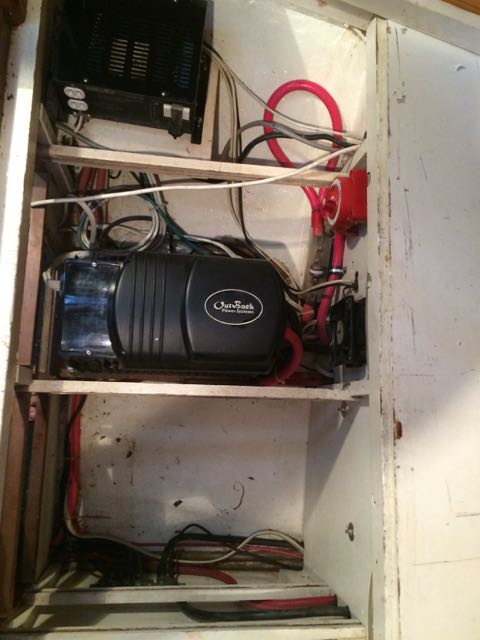For those of you not from England, you may not know but marigolds is the generic, name for dishwashing latex gloves, hideous things, they start off protecting your hands, but in my case usually fill up with chemicals which pickle your fingers all the time you’re cleaning. Anyway, I finished the quarter berth today, which is the last major deep cleaning job. It’s also looking smart.
I cleaned under the berth as well, the bilge area comes up lovely and white with a little scrubbing, and it also makes tracing the wiring easier, for it is in this area that the batteries and lots of heavy electrical kit resides.

I was able to work out the mains supply issues that had been worrying me. The transformer is a straightforward 240 to 110V step down transformer.

The way it is wired, without any isolation means it is always in circuit, which is slightly hazardous, and also not the best configuration. I’m just working out the best way to change this scheme. 80% of the world (according to wiki) is on 220V, but America, Canada, Mexico, Central America and a lot of the Caribbean is 110V as is Japan, so I don’t want to be burning any bridges, especially as I have a plan to end up in Seattle to sell the boat at some point in the future.
Anyway, from now on the challenges are either intellectual, or for my wallet, as I get the systems working and kit her out for offshore sailing.

Paul, if I remember correctly (and I’m too lazy to search for the earlier posting), your inverter is 110v. Plus, you probably already have 110v sockets on board. On top of all that, you’re planning on selling the boat in Seattle (eventually), so I think I’d stick to 110 volt.
I’d wire the 220v shore-power socket directly to that transformer. I’d then put a switchover (A-B power switch) from the output of the transformer to the back of the switchboard (assuming that’s 110v). I’d connect the other side of the A-B selector switch to the 110v shore power. That way, if you’re on 220v shore power, you set the switch to “A” and you have 110v everywhere on the boat. The 110v shore power socket isn’t hot. If you’re somewhere which has 110v, set the switch to “B” and there’s no back-feed to the 220v shore power socket. If you’re running off the inverter, you could either set the A-B to “off” or use a three-way switch, and wire the inverter to “C”.
That way, you choose where you get the power from and only that circuit is wired to the 110v “bus” with no dangerous back-paths to male sockets anywhere.
Another side-effect is if the 220 -> 110v transformer is isolating (and I can’t tell from the picture) then you avoid the ground-loop issues of a lot of marinas, which can cause accelerated galvanic erosion. Effectively, one side of the marina power (the neutral) has managed to get connected to sea water somewhere, and becomes a return path when you’re on shore power. It’ll erode your prop shaft and anything else which is grounded in the boat unless you isolate the AC, which is a nice side-effect of the transformer if indeed it is isolated.
Hi Dermot, I take your point and it’s all logical, but I can’t see the point of having a 110V inverter or 100v sockets, unless I have stuff to run off it, in fact I use a £10 inverter from ebay on Stardust and it meets all our needs offshore, mostly iPod chargers! so the only thing that runs on 110V worth keeping is the water heater. So I have wired the transformer into the water heater circuit and will run the boats electrics on 240V. It’s easy enough to go back to 110V wiring when I need to. The transformer also generates a lot of heat, so when I turn the water heater off, the transformer is isolated. the idea of getting isolation via the transformer is good, but I’m not too worried, I have a galvanic isolator and plenty of sacrificial anodes down there. Will see how we get on tomorrow when I plug it all in!